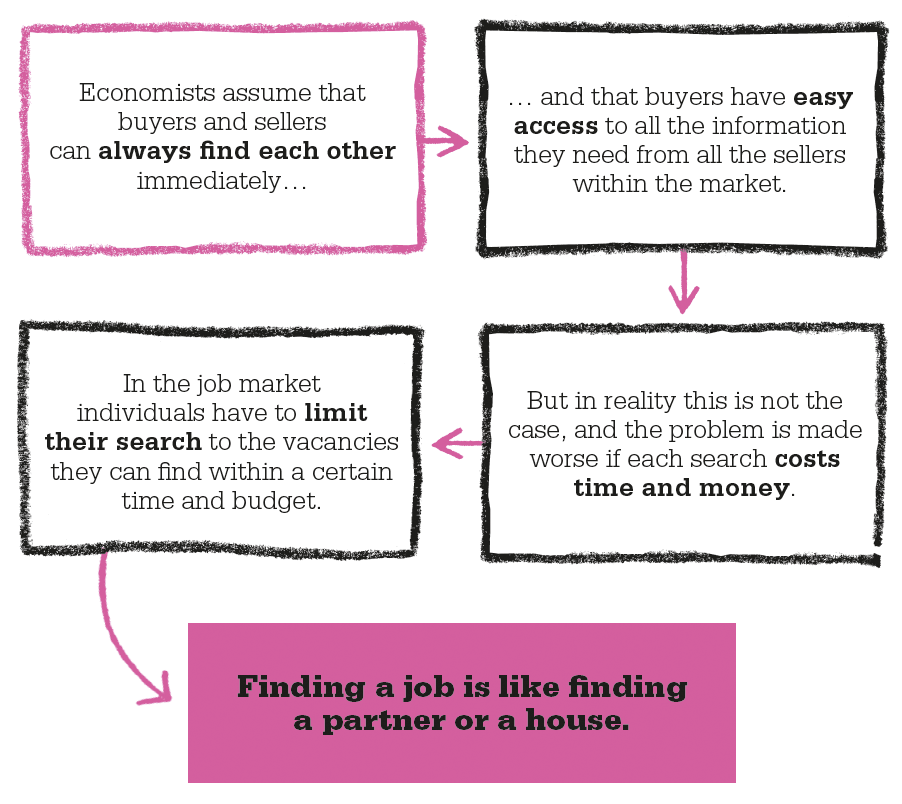

Decision making
George Stigler (1911–91)
1944 British politician William Beveridge argues that if the unemployment rate is high, the number of job vacancies is low.
1971 US economist Peter Diamond shows that costly search frictions prevent the law of “one wage” from working in practice.
1971 US economist Dale Mortensen looks at how unemployment can rise among skilled workers, even when there are jobs available.
1994 British economist Christopher Pissarides provides empirical data and models for search and matching theory.
It is usually easy to decide where to buy bread or soap. There are many supermarkets, and they are easy to find. But what about locating a particular make of used car or an antique musical instrument? According to the classical view of the market—where supply and demand always balance—buyers and sellers find each other immediately, without cost, and have perfect information about the prices of all goods and services. However, anyone who has tried to find a used car—or a new house or partner—knows that it rarely works like this in reality.

Markets are said to have “search frictions” when buyers and sellers do not automatically find each other. Economists have gradually developed “search theory” to investigate these frictions. One of the theory’s main focuses has been on job searches and unemployment.
The classical model of the labor market assumes a labor supply schedule (the number of workers willing to work at a given wage) and a labor demand schedule (the number of jobs offered at a given wage). When the wage for each schedule matches, supply equals demand and the market is in equilibrium. So how can it be that at any one time there are many workers looking for jobs and employers looking for workers?
In the 1960s US economist George Stigler argued that the “one wage” market used by classical economists would only occur where there is no cost for information about wages offered or sought. In any market where products (such as jobs) are all different, searching costs money. The greater the search costs, the wider the range of wages for a similar job will be. People looking for work realize that wages differ between employers and have to decide how far and how long to search. Stigler’s research showed that to conduct an optimal search, workers should reject any wage lower than their “reservation wage” (the lowest they are willing to accept), but accept any offer above it. This model—of drawing a line at an acceptable level—works for searching in any market, even dating agencies.
In 2010, economists Peter Diamond, Dale Mortensen, and Christopher Pissarides were jointly awarded the Nobel Prize for their work on search and matching theory. Diamond found that even a tiny increase in the cost of searching leads to an increase in price of the goods. Buyers are reluctant to pay for a second or third search, so if price rises are small in the place they are searching, sellers know that buyers will not notice because they are not comparing them with the results of other searches.
Searching and matching theory has implications for the efficient design of unemployment benefits. Benefits without conditions might reduce incentives for job seekers to search and to accept job offers. But those that are designed in a way that encourages searching might help to improve the efficiency of labor markets.

Online dating agencies are markets where people are both buyers and sellers. Individuals cannot search indefinitely so they will work most effectively if they search within a range.

In 2011, thousands of Spaniards calling themselves los indignados (the indignant), marched to Brussels to protest against an unemployment rate of 40 percent.
While many people now work in well-paid, satisfying jobs, unemployment is persistently high in some parts of the world. Moreover, the market in jobs is shifting, and good jobs are vanishing even in richer parts of the world.
In March, 2012, nearly half of Spaniards and Greeks under 25 were jobless, and unemployment in South Africa was running at nearly 30 percent. Even in the US, employment climbed above 9.1 percent. This appears to counteract the argument that there are always jobs for those prepared to take lower wages. US economist Edmund Phelps argues that globalization is a big factor in this because jobs created in richer countries tend to be in “non-tradable” sectors such as government and healthcare, while tradable jobs (such as phone-making) have moved to countries such as China and the Philippines, where wages are generally low. Resolving problems like these is one of the chief concerns for economists today.